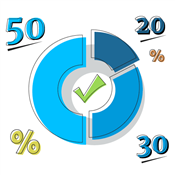How to Invest as a College Student
Ad Disclosure: This article contains references to products from our partners. We may receive compensation if you apply or shop through links in our content. This compensation may impact how and where products appear on this site. You help support CreditDonkey by using our links.
Not sure how to invest as a college student? Check out this guide to find 6 solid investments for college students to invest in for their future.
 |
College students hear it constantly: "Getting a degree is crucial for a good future."
You know what's also important for a good future? Investing.
So how can you start investing as a college student?
In this guide, review your best options for investing as a college student and how to get started.
How to Invest as a College Student
 |
When you hear the word invest, you might think of stocks first.
While stocks can be great for building long-term wealth, there's much more out there. You'll learn six powerful investments that help you build wealth as a college student and set you up for a solid future.
But first, let's cover why investing as a college student could be such a smart decision.
Why You Should Start Investing Early
If you're in your 20s, you have a big advantage when investing. You have more time. It could be more than 40 years until you retire, which means your money can earn a lot of interest in that time without you having to do a thing.
This is the beauty of compound interest.
Your investment makes money from interest, and the interest you made makes more money. Understanding this concept could completely change your financial life.
How to start investing as a student
Getting started is one of the biggest challenges to investing. But it doesn't have to be. It's actually really easy to start so the challenge is mostly psychological.
Here's a 5-step approach to getting starting investing:
- Figure out how much to invest each month. 20% of your income is a good goal to start. But you can start with as little as $10.
- Open an account with an investment app. Investing in mutual funds or index funds is an easy, low-cost, and low-risk way to gain exposure to the market.
- Get help. Robo-advisors use algorithms to buy and sell parts of your investment automatically. The best robo-advisors make it simple and free. You can set up automatic bank transfers every month, and let it optimize your investments over time. They make it easy to invest in funds or individual stocks.
- Diversify your portfolio. Choose different types of investments and with different risk levels. For instance, if you start with index funds and individual stocks, then invest in low-risk CDs for short-term goals.
- Open a retirement account for long-term investing. For example, if you're 25 years old and you invested $240 per month. Assuming a 9% yearly return, you'd be a millionaire by the time you were 65.
Best Investments For College Students
Below you'll learn more about the types of investments, but let's first cover why you could start investing today.
1. Mutual Funds
Risk level: Moderate
Timeline: Long-term (10+ years)
Good for: Creating an instantly diverse portfolio
Buying mutual funds is ideal for new investors because they instantly diversify your portfolio.
Mutual funds are an investment where money is pooled together by many investors to buy a bunch of tradable financial assets, also known as securities. One mutual fund can contain hundreds of securities.
These funds are maintained by professional money managers with the goal of "beating" the stock market. When you buy a fund, you're basically investing in the people that manage it because you trust them to invest it wisely.
Keep in mind that they usually charge fees (called expense ratios) and may require a sizeable initial deposit. Mutual funds can only be purchased at the end of a trading day, at a price set at that time. This is unlike ETFs which can be bought and sold throughout the day on the stock market (more on this later).
Some of the top mutual funds at time of writing included:
- Schwab Fundamental U.S. Large Company Index Fund (SFLNX)
- Voya Russell Large Cap Growth Index Fund (IRLNX)
- Fidelity 500 Index Fund (FXAIX)
- Vanguard Windsor II Fund Investor Shares (VWNFX)
- Shelton NASDAQ-100 Index Direct (NASDX)
A big benefit of investing in a mutual fund is that it offers easy diversification of your investment portfolio. If one company in your fund does poorly, its losses may be offset by the rest of the group.
2. Exchange-Traded Funds
Risk level: Moderate
Timeline: Long-term (10+ years)
Good for: Creating an instantly diverse portfolio
ETFs are a type of mutual fund. They're made of securities that are grouped together to track the price of a particular stock index, commodity, or business sector. They can be traded on the stock market just like individual stocks.
The first ETF was the SPDR S&P 500 ETF (SPY), and it tracks the S&P 500 Index. These are some of the largest market cap companies in the U.S., including plenty of familiar names: Apple, Microsoft, Alphabet, Amazon, Meta, Tesla, Nvidia, Berkshire Hathaway, and JPMorgan Chase.
That means by investing in the SPY ETF, you can get a return that pretty well reflects the state of major businesses in the U.S. economy.
ETFs can contain stocks, commodities, and bonds, and may be cheaper to trade than individual stocks. Also, by trading a fund rather than an individual stock, you remove some of the volatility involved in dealing with individual companies.
3. Individual Stocks
Risk level: High
Timeline: Long-term (10+ years)
Good for: Hand-picking your investments, high potential growth
When you buy a stock, you're essentially buying a small piece of a company.
But before you dive in, keep in mind that stocks are inherently risky. There's no getting around that. It's very easy to lose money, so try to be thoughtful with your investments.
To choose which stocks to invest in, try to stick to things you know. Investing in big companies is one way to do that. Companies like Apple and Google, while no more guaranteed than any other investment, have at least historically offered good returns to their investors.
To get started, consider a commission-free or low-cost investing app, like Robinhood (which also lets you invest in ETFs and cryptocurrency, by the way). They don't charge any fees for trades or account maintenance, so all you're paying for is the stock itself.
If you don't want to worry about picking stocks, consider either a robo-advisor, a social trading app, which lets you learn from other investors, or a guided platform such as Stash, which specializes in helping those new to investing pick stocks based on their risk tolerance and goals.
And as for investing on margin—which is to say, borrowing money from your broker to multiply your returns—it's gambling. Leave it to the experts.
If you're really interested in using leverage, try it out with a paper trading account (like Webull offers). This is where you can invest with fake money so that you aren't stuck living with the consequences of a fun experiment.
4. High-Yield Savings Accounts
Risk level: Low
Timeline: Short-term (<5 years)
Good for: Safe, short-term saving for big expenses
A high-yield savings account is a bank account where you can set aside your money for safekeeping and earn a higher-than-average interest rate.
This is an ideal investment if you're saving up for a big expense within the next five years or so, like a car or vacation. You won't earn as much as you would with a higher-risk investment like stocks, but for short-term investing, this is the best route.
For the time being, you'll probably find the best interest rates by keeping your money with an online bank, such as Ally.
The reason that online banks can offer better rates than traditional, brick-and-mortar banks is that they save a lot on the overhead costs by not having to maintain physical branches.
High-Yield Savings Premier - 5.31% APY
- No account activity or maintenance fees
- $500 minimum opening deposit
- FDIC insured
Discover® Online Savings - $200 Cash Bonus
To qualify for Bonus: Apply for your first Discover Online Savings Account, enter Offer Code CY624 at application, deposit into your Account a total of at least $15,000 to earn a $150 Bonus or deposit a total of at least $25,000 to earn a $200 Bonus. Qualifying deposit(s) may consist of multiple deposits and must post to Account within 45 days of account open date. Maximum bonus eligibility is $200.
What to know: Offer not valid for existing or prior Discover savings customers, including co-branded, or affinity accounts. Eligibility is based on primary account owner. Account must be open when bonus is credited. Bonus will be credited to the account within 60 days of the account qualifying for the bonus. Bonus is subject to tax reporting. Offer ends 09/12/2024, 11:59 PM ET. Offer may be modified or withdrawn without notice. See advertiser website for full details.
CIT Bank Platinum Savings - 5.00% APY
- 5.00% APY with a balance of $5,000 or more
- 0.25% APY with a balance of less than $5,000
- $100 minimum opening deposit
- No monthly maintenance fee
- Member FDIC
5. Certificates of Deposit (CD)
Risk level: Low
Timeline: Short-term (<5 years)
Good for: Safe, modest returns, keeping your money "locked" up
A CD is another interest-earning savings tool offered by most banks.
A CD differs from a savings account in that your money is locked up for a specific amount of time, agreed upon by you and the bank. These terms usually range from 1 to 5 years, with longer terms offering higher rates of return.
Because you can't access your money while it's deposited, CDs offer higher rates of return than high-yield savings accounts generally do.
Certificate of Deposit
- 4.70% APY for 12-month term
- 4.40% APY for 18-month term
- 3.75% APY for 36-month term
- 3.75% APY for 5-year term
9-Month High-Yield CD - 5.05% APY
- No fees
- $1 minimum deposit
- 24/7 online access to funds
- FDIC insured through California Bank of Commerce
CIT Bank Term CDs - Up to 3.50% APY
- Up to 3.50% APY
- $1,000 minimum opening deposit
- No monthly maintenance fee
- Member FDIC
| Term | CD Rates |
|---|---|
| 6 Month | 3.00% APY |
| 1 Year | 0.30% APY |
| 13 Month | 3.50% APY |
| 18 Month | 3.00% APY |
| 2 Year | 0.40% APY |
| 3 Year | 0.40% APY |
| 4 Year | 0.50% APY |
| 5 Year | 0.50% APY |
6. Long-Term Investing with an IRA
Risk level: Moderate
Timeline: Long-term (10+ years)
Good for: Retirement planning with tax benefits
Lots of people see investing as a way to get rich quickly. But if you're really looking for a smart, long-term play, consider opening a retirement account.
An Individual Retirement Account, or IRA, lets you invest with tax benefits. Any investment in an IRA, depending on the type of account, is either tax-free or tax-deferred. And if you don't already know, you'll soon learn that taxes can eat up a whole lot of your profits.
One of the great things about IRAs is that you can invest in a wide range of different things, such as stocks, mutual funds, and ETFs, as well as gold, Bitcoin, and more, as long as you can find a custodian who offers them.
Just keep in mind that, you won't be able to withdraw your money from an IRA until the age of 59 1/2 without incurring penalties.[1] Make sure you set aside enough to live on in the meantime.
What To Do vs What Not To Do
Before choosing which investment is best for you, here are a handful of important investing tips to consider.
Do invest often
Some people think you need $1,000 or $10,000 to start investing. But that's not true.
You can start with as little as $5 to $10.
And you should so you can start investing ASAP.
The best micro-investing apps make it easy to invest small amounts of money. Some even do it for you automatically.
Since the stock market can go up and down in value unpredictably, by investing often you can minimize the negative impact of the market dips.
Do plan for 20 years from now
A big mistake for new investors is trying to make a lot of money quickly. This can lead to making poor decisions about what to invest in and how much to invest.
On the other hand, if you look for low-risk investments that will grow over 20 years, then you can still make great returns over time.
You'll also invest money that you won't need for a while. And have a mindset that can weather the inevitable ups and downs in the market.
Don't invest more than you can afford to lose
Investments always involve risk. And more risk often means you could make a greater return. This can be a lot of fun when things go well, but if you invest your rent for this month and it doesn't go well, then investing can become a nightmare.
Pay your bills and living expenses first. Build up an emergency fund for 3 to 6 months. Then invest the extra money you have.
Don't withdraw when the market dips
Your investments will go down in value at some point. If this was your hard-earned money, these can be tough times.
But in most cases, you won't want to withdraw your money.
If you think it will come back up, then hold. In fact, investors who make the highest returns invest more when the market dips.
Don't do it all yourself
Researching investments is one of the best ways to succeed in investing. But as a new investor, it can be difficult to understand what to look for. And it can take up a lot of time.
Now, you could always hire a financial advisor. But if you don't have a lot to invest, then it would probably cost more than it's worth.
Fortunately, you can now get help from free robo-advisors.
A robo-advisor uses algorithms to buy and sell stocks and they can be very profitable. You can find them at many online brokerage platforms like Betterment and Acorns.
Investments vs Student Loans?
Should you invest if you have student loans?
If money's tight, then your student loan comes first. But if you can meet your monthly expenses (food, rent, utilities, etc.) and make your student loan payment, then you'll want to consider investing your extra money.
To make this decision, compare your interest rates.
Most student loan interest rates are very low, usually between 2.5% and 6%. But the stock market has consistently made 10% returns over the course of its history (a bit less when factoring in inflation).
Therefore for most people, you'll make more money by investing your extra money in the stock market, instead of paying down your student loan.
How do you invest and manage student loan debt?
You can pay for essentials and your student loan payment first. Then invest a portion of your extra money. Here's a real-world example to show you how that could pay off over time.
Let's say your student loan is $10,000. The interest rate is 5% and the monthly payment is $200.
If you had an extra $100 and used it to pay more on your student loan each month, then you'd save ~$450 over the course of your loan. And you'd pay it off in just under 3 years.
On the other hand, if you invested that extra $100 in the stock market and the returns were 10% per year, then you'd have made ~$600 in 3 years' time. That's 33% more!
For most people with student loan interest rates under 6%, it'd make sense to invest your extra money in the stock market.
Bottom Line
You don't have to be rich to invest, and you don't have to be an expert, either. Thanks to online accounts with zero minimums and commission-free apps, investing is more accessible than ever.
If you're hesitant about getting started, try it out with a regular investment of a small amount of money.
Even $5 or $10 a month is enough to make a difference over the long term, and it will help to remove some of the fear that just comes with inexperience.
Just remember, you're not in it to get rich overnight. Play it safe and smart, take it slow, and before you know it, your little financial seed will have grown into a tree.
References
- ^ Internal Revenue Service. IRA FAQs - Distributions (Withdrawals), Retrieved 8/15/2022
Jeremy Harshman is a creative assistant at CreditDonkey, a personal finance comparison and reviews website. Write to Jeremy Harshman at jeremy.harshman@creditdonkey.com. Follow us on Twitter and Facebook for our latest posts.
Note: This website is made possible through financial relationships with some of the products and services mentioned on this site. We may receive compensation if you shop through links in our content. You do not have to use our links, but you help support CreditDonkey if you do.
|
|
| ||||||
|
|
|

















